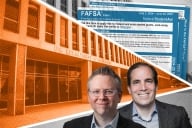You have /5 articles left.
Sign up for a free account or log in.
Following months of debate, Grinnell College announced Saturday that its board had voted to keep the institution need-blind in admissions. That news cheered many students and alumni who were alarmed when the college announced last year that it was considering the possibility of moving away from considering all applicants without regard to financial need. Last year's announcement caused a stir among private colleges because Grinnell's $1.5 billion endowment is among the largest of liberal arts colleges, leaving many wondering if this was a sign that more colleges would move away from need-blind admissions.
While Grinnell will remain need-blind for now, the college made clear on Saturday that things were going to change:
- The commitment is only for the next two years. If Grinnell can't find a way to curb growth in its discount rate (the percentage off sticker price provided by the college in aid, on average) and to reduce the share of its operating budget paid by the endowment, the board may reconsider.
- To control aid expenses, the college is raising loan limits and vowing to be more rigorous in identifying assets that may allow some students on financial aid to pay for more of their expenses.
- And to minimize the need for financial aid, the college plans to take steps -- in part by using non-need-based aid -- to recruit a greater number of wealthy students.
Raynard S. Kington, the president of Grinnell, said in an interview after the board vote Saturday that he believes all private colleges will need to look carefully at their aid policies to try to balance their desire to be generous with financial realities. "A board not asking these sorts of things is asleep at the switch," Kington said.
In the interview, as he has on campus for the past months, Kington argued that endowment size alone is not a way to judge a private college's wealth. By that measure, he said, Grinnell is well-off, but equally important for private colleges are tuition revenue and private giving, and he said that Grinnell is much less well-off than its peers in those areas. As a result, he said, the college has serious financial challenges -- even with its endowment -- that force a reconsideration of financial aid policies.
He noted that only 12 percent of Grinnell students don't receive any financial aid. While there are many private colleges where hardly anyone pays full freight, most highly competitive private colleges (the institutions with which Grinnell competes) have anywhere from 30 to 50 percent of students with enough family wealth to pay for even this expensive form of higher education.
Other key statistics cited by Kington: 50 percent of Grinnell's budget comes from the endowment payout each year, a level he said was too high, given the expectation of relatively marginal endowment growth (if that) in the coming years. And then there's the discount rate of 62 percent, up 5 percentage points over the last three years.
Those numbers have added up to an academically talented student body, and an economically diverse one -- with more than 24 percent of students eligible for Pell Grants (a higher ratio than is the case at many other elite private colleges). But Kington said that, economically, the path the college has been on is "unsustainable."
A Two-Year Window for Change
For the next two years, he said, the college will try various strategies to shift some of those statistics. While he said that the discount rate should be in the "low 50s," not where it is, he said that the board did not set a firm target on that or any other metric. He noted that more revenue -- if donations increase, for example -- is also part of the equation. But he said that the board will need to see real change -- at a minimum an end to the increase in the discount rate, and some decrease in the percentage of budget paid for by endowment. If those changes don 't happen within two years, he said, the board will revisit the ability to maintain need-blind admissions.
One change now will be a shift in loan limits. Currently, Grinnell students are assured that no more than $3,000 in their financial aid package will come from loans. Starting next year, the limits will be raised to $3,500 for the first year, $4,500 for the second year, and $5,500 for the third and fourth years. (Since the economic downturn started in 2008, several other elite institutions, including Cornell University and Dartmouth and Williams Colleges, have raised loan expectations for those on financial aid.)
Grinnell also plans to be "more aggressive" than it has been in the past on enforcing financial aid deadlines, and on gathering data about the ability of students' families to pay for college, Kington said. In particular, he said that Grinnell would push to "make sure than noncustodial parents give financial information to us." He was quick to say that there are some noncustodial parents who are "not involved in the child's life," but said that there are others with assets that should be considered.
Perhaps the most controversial plan Grinnell is adopting is to try to attract more students with wealth. Unlike some of its competitors, Grinnell has long awarded some non-need-based aid. Kington said that the change was a matter of "using merit aid more strategically." By offering aid to students whose families could afford most of Grinnell's charges (or who are willing to pay most of them), Grinnell could see net tuition revenue go up even if it spends more on non-need-based aid, Kington said. Grinnell can do this, he said, without abandoning its commitment to racial or economic diversity.
Extensive discussions on campus about the financial dilemmas facing Grinnell have resulted, according to student and faculty leaders, in a general consensus that some changes need to be made in financial aid policies. Colleen Osborne, student body president, said that the most important thing to happen Saturday was the affirmation of need-blind admissions. "I think we acknowledge that our current model is unsustainable," she said. "The issue for right now is that we are staying need-blind."
Grinnell administrators also got high points from many on campus for holding numerous forums and posting information about budget options on the college's website.
But spending more non-need-based on wealthier students rubs some the wrong way.
The Scarlet & Black, Grinnell's student newspaper, endorsed the idea of higher loan limits, but questioned the strategy of trying to attract more wealthy students. In an editorial that ran just before the board vote, the newspaper said: "Instituting policies that benefit high-income students to the detriment of middle- and low-income students is fundamentally unjust. It perpetuates class inequality by limiting the access of lower-income students to a high-quality education -- specifically, students who already lack many of the privileges of high-income students. Furthermore ... many of these policies would in fact decrease the student body’s academic profile, which is contrary to the college’s dedication to academic excellence."
Kington rejected the idea that the college would be giving aid to students who weren't academically worthy. He noted that decisions on non-need-based aid are made after students have been admitted, and said that someone "on the edge of being admitted" probably wouldn't receive such aid. He also noted that there is "a strong correlation between academic performance and economics," such that many of those who are admitted and are able to pay for most of their Grinnell education also happen to be outstanding students.
Grinnell will still be using non-need-based aid for reasons other than attracting wealthier students, he said. But it is simply trying to be "more strategic" about using this aid to attract more students who can pay most of their expenses.
A False Dichotomy?
The move by Grinnell to shift its strategy on non-need-based aid comes at a time when some private college presidents are trying to organize a movement to move away from what is commonly called "merit aid" in favor of shifting more of the money to need-based aid.
Kington said that, "intellectually and at a national level, I understand and agree that the result of the increase in merit aid over the course of the last couple of decades has resulted in more limited resources going to wealthier families," so he said he is sympathetic to that movement. But he said that at "places like Grinnell we have to use merit aid to get a diverse student body along many dimensions."
From the point last year when Kington warned the campus that need-blind admissions might be at risk, much of the focus of discussion at Grinnell has been on the importance of preserving need-blind admission. While very few private colleges are need-blind in admission while also pledging to meet full student need, as Grinnell still does, many at Grinnell became aware that it is possible to leave that group. Last summer, Wesleyan University, another top liberal arts college, announced it was moving away from need-blind admissions. (Wesleyan, however, awards all aid that it provides based on economic need.)
Even as Grinnell students are cheering the preservation of need-blind admissions, and some at Wesleyan continue to object to the decision there, Kington said that he thinks it is wrong to view need-blind and non-need-blind as a dichotomy. Indeed both Wesleyan (no longer need-blind) and Grinnell (still need-blind) will be taking steps next year that should result in more students with greater ability to pay enrolling: Wesleyan is doing so by being "need-aware" for the final 10 percent of the class admitted, and Grinnell is doing so with non-need-based aid. And both colleges are pledging to maintain efforts to enroll low-income and minority applicants.
"This idea that colleges are either looking at need explicitly or being completely blind to need is not the reality," Kington said. "We shape our application pool in all sorts of ways -- geographic, male-female balance, we look at lots of dimensions to shape a class," Kington said. "Even if we aren't looking explicitly at financial need" in admissions decisions, he said, colleges are always aware that they "have to bring in a certain amount of revenue" in the class being selected.
The Choices for Colleges
Ronald G. Ehrenberg, director of the Cornell University Higher Education Research Institute, who has written extensively on colleges' admissions and aid strategies, predicted that more colleges would be considering the kinds of moves made by Grinnell or Wesleyan or Cornell or Williams or others.
"The tradeoff between social responsibility (providing opportunities for students from all socioeconomic backgrounds to attend our institutions) and having the necessary resources to maintain the quality of programs is a difficult one," he said via e-mail. He said that there are no easy solutions.
Ehrenberg predicted that institutions that move away from need-blind or use non-need-based aid to attract more wealthy students would likely continue "the focus on lower income students, as measured by Pell Grant recipients."
But he said that there are real dangers to higher education from an increased emphasis on non-need-based aid to attract those who can pay. "If Grinnell does it, this may put pressure on Williams and Middlebury to do it and then we will see merit aid putting further pressure on need-based aid," he said.
Added Ehrenberg: "The loser in all of this will be middle-income students, above the Pell Grant level -- institutions will respond to what is measurable. So there is a danger that the student bodies at our institutions will become increasingly bifurcated -- more Pell Grant recipients, more relatively wealthy students, fewer students in between (middle-class melt revisited)."








